This pub was Beeston’s main post office, built in the mid 1930s. The post office, formerly in the High Road, occupied a new building in the square early this century. In 1934, the post office was rebuilt at the junction of Chilwell Road and Foster Avenue and is now this Wetherspoon pub. More recently, in 1995, the Royal Mail’s new Nottingham District Sorting Office was built on Padge Road.
Prints and text about the history of Beeston.

The text reads: Finds of Stone Age axe-heads and Bronze Age dug-out canoes show that this area has been inhabited for thousands of years. In the early days of recorded history, the Romans built a fort at nearby Attenborough. After the Romans left, Angles and Saxons sailed up the River Trent to settle here, naming the place Bestun, or “rye settlement”.
The manor was later given by William the Conqueror to his illegitimate son, William Peveril. It was one of some 60 manors held by Peveril in Nottinghamshire alone. An enormously wealthy man, he set up Lenton Priory in the early 1800s, when the monks were to pray for his soul.
Beeston Church, probably established in Saxon times, passed to the Priory. When the Priory was closed down by King Henry VIII it regained its independence. Beeston Manor, having returned to royal hands, was sold by Elizabeth I to Nicholas Strey. He and his son had pretensions beyond their status, displaying an unofficial coat of arms but denying the fact when enquiries were made by the Heralds. The present Manor House dates largely from the 17th and early 18th centuries. It was restored in 1981. Richard Strey, the last Lord of the Manor, died in 1797.
Top: Beeston parish church in 1841 and 1904
Above: The Manor House.
Prints and text about Wollaton Hall.
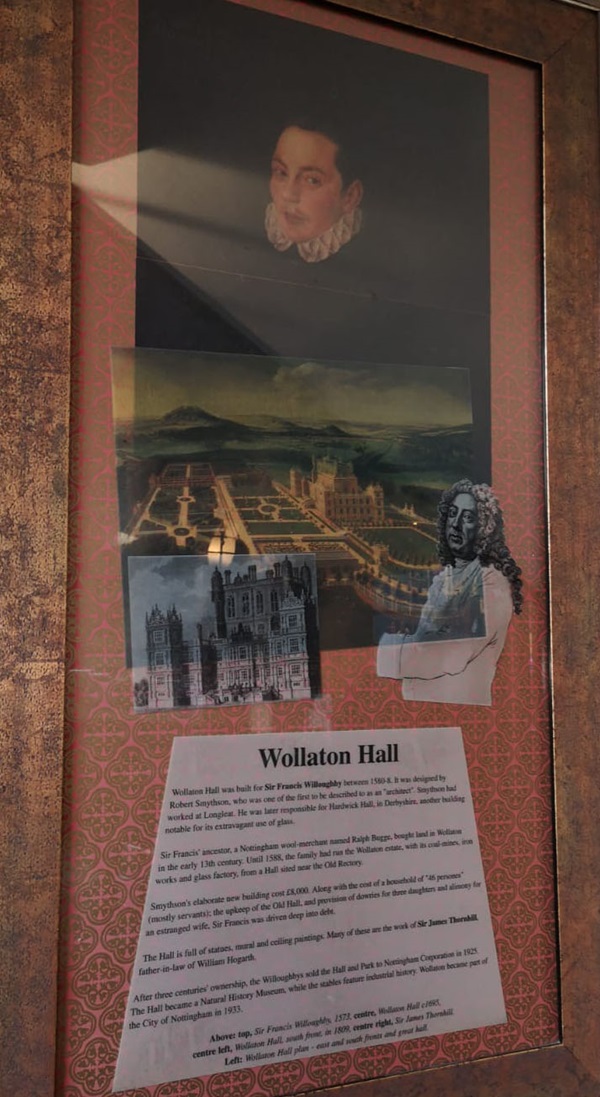
The text reads: Wollaton Hall was built for Sir Francis Willoughby between 1580-8. It was designed by Robert Smythson, who was one of the first to be described to as an “architect”. Smythson had worked at Longleat. He was later responsible for Hardwick Hall, in Derbyshire, another building known for its extravagant use of glass.
Sir Francis’ ancestor, a Nottingham wool-merchant named Ralph Bugge, bought land in Wollaton in the early 13th century. Until 1588, the family had run the Wollaton estate, with its coal-mines, iron works and glass factory, from a Hall sited near the Old Rectory.
Smythson’s elaborate new building cost £8,000. Along with the cost of a household of “46 persones” (mostly servants); the upkeep of the Old Hall and provision of dowries for three daughters and alimony for an estranged wife, Sir Francis was driven deep into debt.
The Hall is full of statues, mural and ceiling paintings. Many of these are the work of Sir James Thornhill, father-in-law of William Hogarth.
After three centuries’ ownership, the Willoughbys sold the Hall and Park to Nottingham Corporation in 1925. The Hall became a Natural History Museum, while the stables feature industrial history. Wollaton became part of the City of Nottingham in 1933.
Above: top, Sir Francis Willoughby, 1573, centre, Wollaton Hall 1695, centre left, Wollaton Hall, south front in 1809, centre right, Sir James Thornhill
Left: Wollaton Hall plan – east and south fronts and great hall.
Prints and text about transport in Beeston.
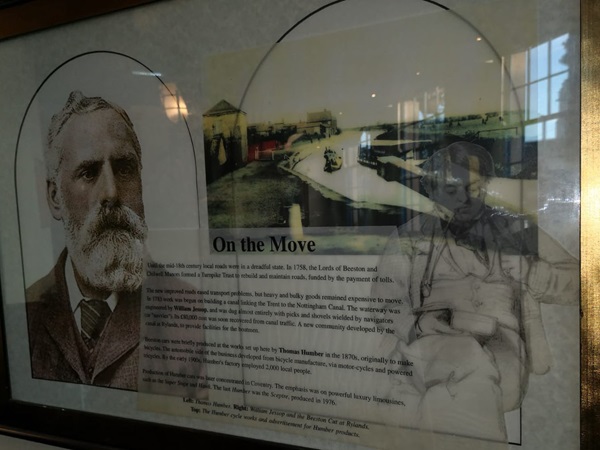
The text reads: Until the mid-18th century local roads were in a dreadful state. In 1758, the Lords of Beeston and Chilwell Manors formed a Turnpike Trust to rebuild and maintain roads, funded by the payment of tolls.
The new improved roads eased transport problems, but heavy and bulky goods remained expensive to move. In 1783 work was begun on building a canal linking the Trent to the Nottingham Canal. He waterway was engineered by William Jessop, and was dug almost entirely with picks and shovels wielded by navigator (or “navvies”). Its £80,000 cost was soon recovered from canal traffic. A new community developed by the canal at Rylands, to provide facilities for the boatmen.
Beeston cars were briefly produced at the works set up here by Thomas Humber in the 1870s, originally to make bicycles. The automobile side of the business developed from bicycle manufacture, via motor-cycles and powered tricycles. By the early 1900s, Humber’s factory employed 2,000 local people.
Production of Humber cars was later concentrated in Coventry. The emphasis was on powerful luxury limousines such as the Super Snipe and hawk. The last Humber was the Sceptre, produced in 1976.
Left: Thomas Humber Right: William Jessop and the Beeston Cut at Rylands
Top: The Humber cycle works and advertisement for Humber products.
A print and text about William Thompson.
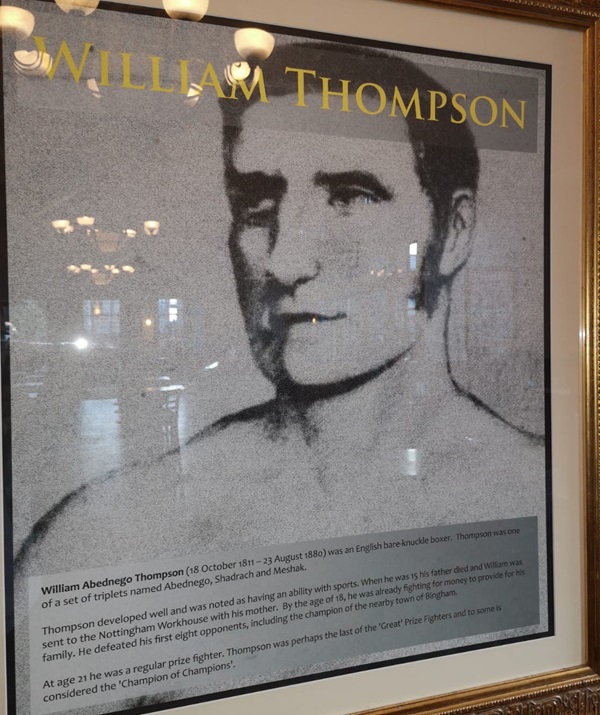
The text reads: William Abednego Thompson (18 October 1811 – 23 August 1880) was an English bare-knuckle boxer. Thompson was one of a set of triplets named Abednego, Shadrach and Meshak.
Thompson developed well and was noted as having an ability with sports. When he was 15 his father died and William was sent to the Nottingham Workhouse with his mother. By the age of 18, he was already fighting for money to provide for his family. He defeated his first eight opponents, including the champion of nearby town of Bingham.
At age 21 he was a regular prize fighter. Thompson was perhaps the last of the `Great’ Prize Fighters and to some is considered the `Champion of Champions`.
Old photographs of Beeston.

Top: The High Road, 1905
Above: The Square, 1910, with Chilwell Road to the right and Church Street to the left.
Aspects of Beeston’s industrial past lace and bicycles.

Top: Swiss Mills
Above: Humber Cycle Works.
Prints of the University of Nottingham, and it’s most famous graduate David Herbert Lawrence.
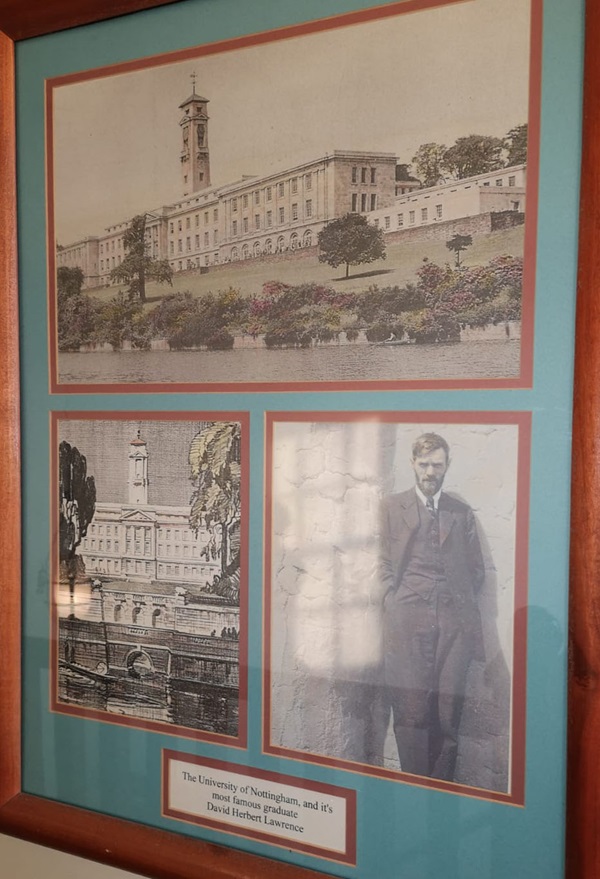
External photograph of the building – main entrance.
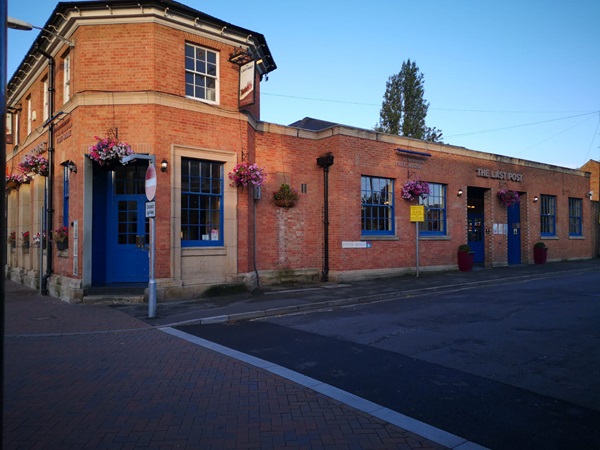
If you have information on the history of this pub, then we’d like you to share it with us. Please e-mail all information to: pubhistories@jdwetherspoon.co.uk